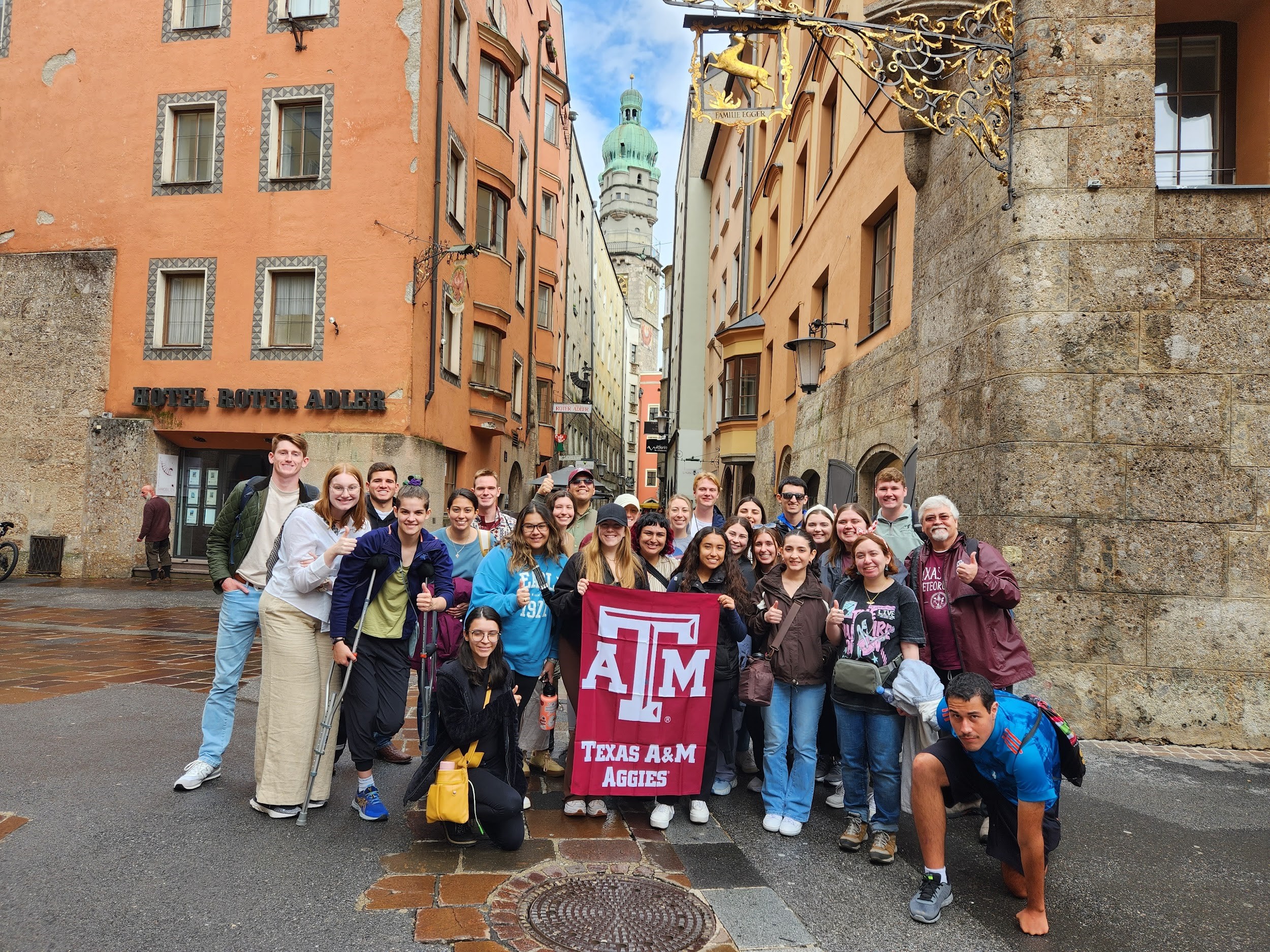
An American abroad may get strange looks from the locals for their clothes or behavior, but a group of undergraduate students from Texas A&M University's Department of Atmospheric Sciences stood out more than most tourists on a European study abroad trip in May 2023.
During a seven-day stay in Munich, Germany, students in pairs walked the city for an hour at sunrise and sunset and also biked from the central train station into the countryside and back to collect atmospheric data for a study. The data collection process included carrying a temperature and humidity logger on a small pole well away from the participants’ bodies, so that their body heat wouldn’t impact the data.
“There were a lot of curious people,” said Nathaniel Breaux ’26, one of the student participants.
They also got one excited “Gig ‘em!” called from a passing motorist, recalled Mark Zarfoss ’24.
One night and the following morning, the 26 students on the trip walked designated routes that included densely built-up areas near Munich’s old city and the famous English Garden. Their paths varied from concrete to packed dirt and grass. The weather was clear and sunny, which was perfect for both sightseeing and collecting data. It was a lovely way to experience Munich while learning new research skills. While students walked, they tracked their routes with GPS monitoring on their phones. Their location was later combined with the atmospheric conditions to create a robust dataset that will be used to investigate the urban heat island (UHI) effect.
This work is important when you’re looking at where you want to live. Climate change is making the urban heat island effect worse.
According to the Environmental Protection Agency, structures such as buildings, roads and other infrastructure absorb and re-emit the sun's heat more than natural landscapes such as forests and water bodies. Urban areas, where these structures are highly concentrated and greenery is limited, become “islands” of higher temperatures relative to outlying areas; thus, the urban heat island effect. This manifests most noticeably at night, when temperatures in the city are significantly higher than in rural areas or spaces with more greenery.
Several of the students involved in the study presented a poster about their findings at the American Meteorological Society 104th Annual Meeting, held earlier this year in Baltimore. While there are many applications for this type of data, Sierra Hill '24 says that wasn't the group's true motivation.
“We weren’t looking at human health or economic elements, we were just collecting the data,” Hill explained.
“There are clear opportunities to do more with this research at a higher level,” Zarfoss added.
“These types of projects can diagnose where heat is most intense,” noted Juliette Rocha ‘24.
Understanding patterns of heat where people live can lead to designing better cities that mitigate the increase in heat of the UHI effect by including lots of green space. This work is especially important in a time of climate change, where extreme heat is becoming a life-threatening issue and creating naturally cooler cities could be a life-saving advancement.
“This work is important when you’re looking at where you want to live,” agreed Hill. “Climate change is making the urban heat island effect worse.”

Though the scope of the project was very limited, the students agreed that it was a great first experience of boots-on-the-ground research. Several of the students are looking ahead to graduate school or careers in research and felt that this project was the perfect introduction to the process, from designing the study to conducting the research and compiling the data, then analyzing and communicating the results. “This project has been really valuable,” said Breaux, who plans to pursue a career in meteorological numerical modeling.
Zarfoss was the only participant on the research trip who wasn't studying meteorology. His major is in geographic information science and technology (GIST) within the Department of Geography, which involves creating maps with nested layers of information. The Munich project was a beneficial exercise as he was able to take the data collected and present it spatially. It was also a great professional development opportunity, as he was collaborating with others who didn’t quite understand the work that he does. As he enters the workforce in the months to come, he recognizes the importance of good communication while working on diverse teams.
The trip included time in Austria and Italy as well as Germany. In addition to the UHI data collection in Munich, the students also toured labs, attended lectures, met with scientists at the German Weather Service and explored areas of cultural and historic significance.
The group was also able to study how airflow and weather is impacted by mountains while in Germany — a topic of special interest to Hill. She hopes to attend graduate school to study atmospheric dynamics, which looks at how friction influences how air moves. “It’s hard to study how air curls over mountains in College Station, when the highest peak is Mt. Aggie,” she said.
Experience Undergraduate Research
Students in the College of Arts and Sciences at Texas A&M University work on the frontiers of discovery, even as undergraduates. As a vital component of this high-impact experience, they partner with faculty, graduate students and fellow researchers to solve cutting-edge problems, publish results in leading journals, and gain technical and critical-thinking skills that prepare them for their future careers. Learn more about undergraduate research opportunities in ArtSci.

